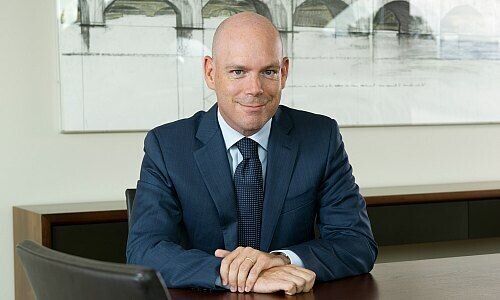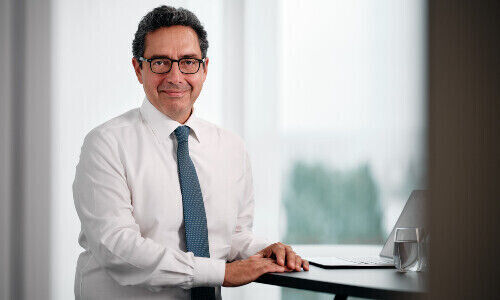Rothschild & Co Bank has benefited hugely from Credit Suisse’s turmoil. This can be seen in the increase in its half-year result and in the numerous client advisor teams it has brought in. Growth is also expected in the second half of the year, as Laurent Gagnebin, CEO of Rothschild & Co Bank told finews.com in an interview.
Zurich-based Rothschild & Co Bank posted a profit of over 25 million francs in the first half of 2023, compared to 9 and a half million francs in the same period last year, representing an increase of 171 percent.
Laurent Gagnebin, Rothschild & Co Bank posted a massive increase in profits in the first half of 2023. What were the main reasons for this?
On the one hand, this was a result of the integration of Banque Pâris Bertrand and of our steady expansion of customer service capacity, which has led to good asset inflows. On the other hand, the changed interest rate situation also had a positive impact.
Which role did the situation at Credit Suisse play in recent months?
We felt that Credit Suisse employees and customers were increasingly unsettled. But we generally had considerable inflows of new money, including in other markets such as Germany, Spain, and Israel.
What did the gain look like exactly?
As mentioned, Credit Suisse clients were looking to diversify their banking relationships or switch altogether.
«We have hired a total of more than 20 new advisors in the current year»
We also received calls from client advisors looking to jump ship. But we were extremely selective, as we have been in the past, and only hired people who were a perfect fit for our culture.
How did this affect the development of net new money and assets under management?
We recorded total net new assets of around 800 million Swiss francs, and our assets under management increased by more than four percent to around 30 billion Swiss francs.
You have also expanded your workforce considerably since the beginning of the year. Can you give us some details about that?
We have hired a total of more than 20 new consultants this year. In addition to the recently announced team for Central and Eastern Europe in Zurich, additional employees joined us in Geneva, Germany, Spain and Luxembourg.
We also brought on board Thomas Bamert, a proven pension expert. This is a topic of great concern to the Swiss. Finally, due to the growth in net new money and the numerous client wins, we also expanded our back office, especially in the area of client onboarding.
What are your further personnel plans – are you still hiring from other Swiss banks?
Rothschild & Co Bank wants to continue to grow. Since we pay very close attention to the individual personality, it doesn't matter whether new employees come from one of the larger or smaller banks. Our goal is to attract the best talent to Rothschild & Co.
«Of course, Credit Suisse’s downfall is not a good development»
Israel is also a growth market. We are convinced that our offering, which is focused on long-term asset development, coupled with the global network within the group, is very much in line with the current needs of clients. We offer stability and security, and we take time for our customers. Each client advisor looks after just under 30 clients on average.
How do you assess the future supremacy of the «new» UBS in the Swiss financial center?
Of course, Credit Suisse’s downfall is not a good development. However, I am convinced that this will not be a disadvantage for the financial center in the long term. We have many banks and healthy competition. If customers feel that one of the providers is too big or not customer-focused enough, they will switch.
Do you have to worry about lump risk?
No. Everyone involved is aware of the risks and will act prudently.
What are your plans until the end of the year - what are the priorities?
We are continuing to expand the pension business and are concentrating on integrating our new employees and expanding in Germany and Israel.
«There has certainly been a dip«
We may open an additional location and we will certainly hire one or two more customer advisors in Switzerland. We are also continuing to invest in our systems and digital presence.
Is an acquisition possible – if so, with what profile?
In principle, yes. However, such an acquisition target would have to be a perfect fit for us, as was the case with Banque Pâris Bertrand. Since this is generally rather difficult, our focus is more on organic growth.
Has the Swiss financial center, and with it Swiss banking, suffered as a result of the turbulence surrounding Credit Suisse?
There has certainly been a dip. But in the long term, I don't see this having a negative impact on the financial center. The banks in Switzerland have done their job and the financial center continues to be very attractive for private and institutional clients.
What were the reactions of your foreign clientele?
We received very little feedback from foreign clients. It was mostly a brief assessment of how we see the situation. But that's about it.
Should there be more and better-coordinated cooperation between the various stakeholders (banks, authorities, politicians) in the Swiss financial center to ensure that Swiss banking remains successful and unique in the future?
Yes, that is of course desirable. I also have the feeling that the will to do so is greater today than it was a few years ago. There are challenges that we can only solve by working together.
These generally include the global positioning of the financial center and the regulatory framework in Switzerland, as well as topics such as data security, dealing with artificial intelligence, or interactions with foreign stakeholders.
Laurent Gagnebin joined Rothschild Wealth Management Equitas belonging to Zurich-based Rothschild & Co Bank, in the fall of 2011. Previously, he was head of Investec Bank in Geneva. He entered banking via Goldman Sachs Bank in Geneva, having previously graduated from the École hôtelière de Lausanne and worked in the hotel industry for several years. He has been CEO of Rothschild Bank, Switzerland since mid-2016.




































